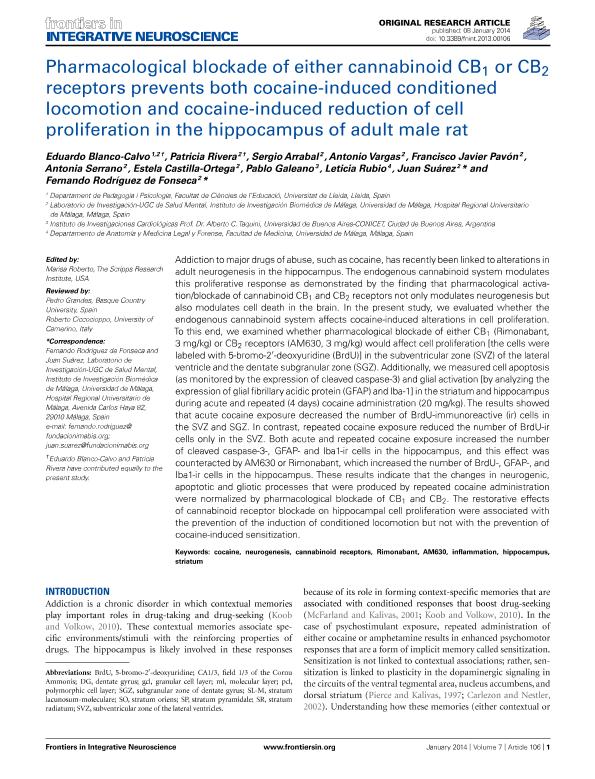Artículo
Pharmacological blockade of either cannabinoid CB1 or CB2 receptors prevents both cocaine-induced conditioned locomotion and cocaine-induced reduction of cell proliferation in the hippocampus of adult male rats
Blanco Calvo, Eduardo; Rivera, Patricia; Arrabal, Sergio; Vargas, Antonio; Pavon, Francisco Javier; Serrano, Antonia; Castilla Ortega, Estela; Galeano, Pablo ; Rubio, Leticia; Suaréz, Juan; Rodríguez de Fonseca, Fernando
; Rubio, Leticia; Suaréz, Juan; Rodríguez de Fonseca, Fernando
 ; Rubio, Leticia; Suaréz, Juan; Rodríguez de Fonseca, Fernando
; Rubio, Leticia; Suaréz, Juan; Rodríguez de Fonseca, Fernando
Fecha de publicación:
01/2014
Editorial:
Frontiers
Revista:
Frontiers in Integrative Neuroscience
ISSN:
1662-5145
Idioma:
Inglés
Tipo de recurso:
Artículo publicado
Clasificación temática:
Resumen
Addiction to major drugs of abuse, such as cocaine, has recently been linked to alterations in adult neurogenesis in the hippocampus. The endogenous cannabinoid system modulates this proliferative response as demonstrated by the finding that pharmacological activation/blockade of cannabinoid CB1 and CB2 receptors not only modulates neurogenesis but also modulates cell death in the brain. In the present study, we evaluated whether the endogenous cannabinoid system affects cocaine-induced alterations in cell proliferation. To this end, we examined whether pharmacological blockade of either CB1 (Rimonabant, 3 mg/kg) or CB2 receptors (AM630, 3 mg/kg) would affect cell proliferation (the cells were labeled with BrdU) in the subventricular zone (SVZ) of the lateral ventricle and the dentate subgranular zone (SGZ). Additionally, we measured cell apoptosis (as monitored by the expression of cleaved caspase-3) and glial activation (by analyzing the expression of GFAP and Iba-1) in the striatum and hippocampus during acute and repeated (4 days) cocaine administration (20 mg/kg). The results showed that acute cocaine exposure decreased the number of BrdU-immunoreactive (ir) cells in the SVZ and SGZ. In contrast, repeated cocaine exposure reduced the number of BrdU-ir cells only in the SVZ. Both acute and repeated cocaine exposure increased the number of cleaved caspase-3-, GFAP- and Iba1-ir cells in the hippocampus, and this effect was counteracted by AM630 or rimonabant, which increased the number of BrdU-, GFAP- and Iba1-ir cells in the hippocampus. These results indicate that the changes in neurogenic, apoptotic and gliotic processes that were produced by repeated cocaine administration were normalized by pharmacological blockade of CB1 and CB2. The restorative effects of cannabinoid receptor blockade on hippocampal cell proliferation were associated with the prevention of the induction of conditioned locomotion but not with the prevention of cocaine-induced sensitization.
Archivos asociados
Licencia
Identificadores
Colecciones
Articulos(ININCA)
Articulos de INST.DE INVEST.CARDIOLOGICAS (I)
Articulos de INST.DE INVEST.CARDIOLOGICAS (I)
Citación
Blanco Calvo, Eduardo; Rivera, Patricia; Arrabal, Sergio; Vargas, Antonio; Pavon, Francisco Javier; et al.; Pharmacological blockade of either cannabinoid CB1 or CB2 receptors prevents both cocaine-induced conditioned locomotion and cocaine-induced reduction of cell proliferation in the hippocampus of adult male rats; Frontiers; Frontiers in Integrative Neuroscience; 7; 106; 1-2014; 1-13
Compartir
Altmétricas



